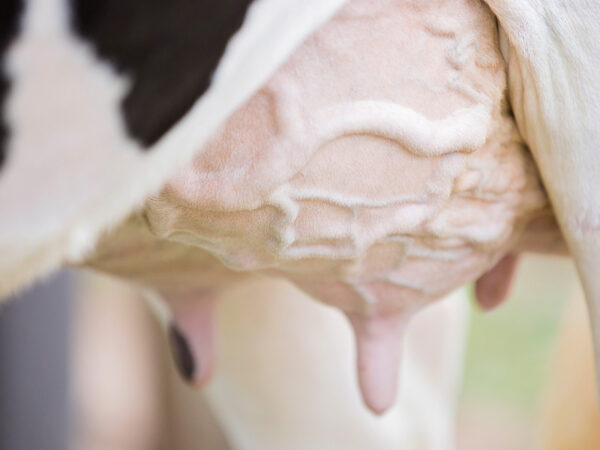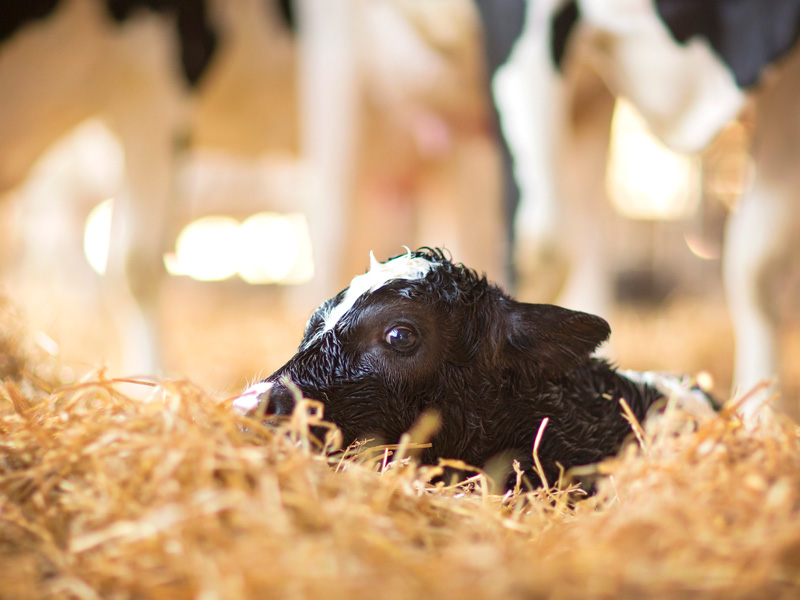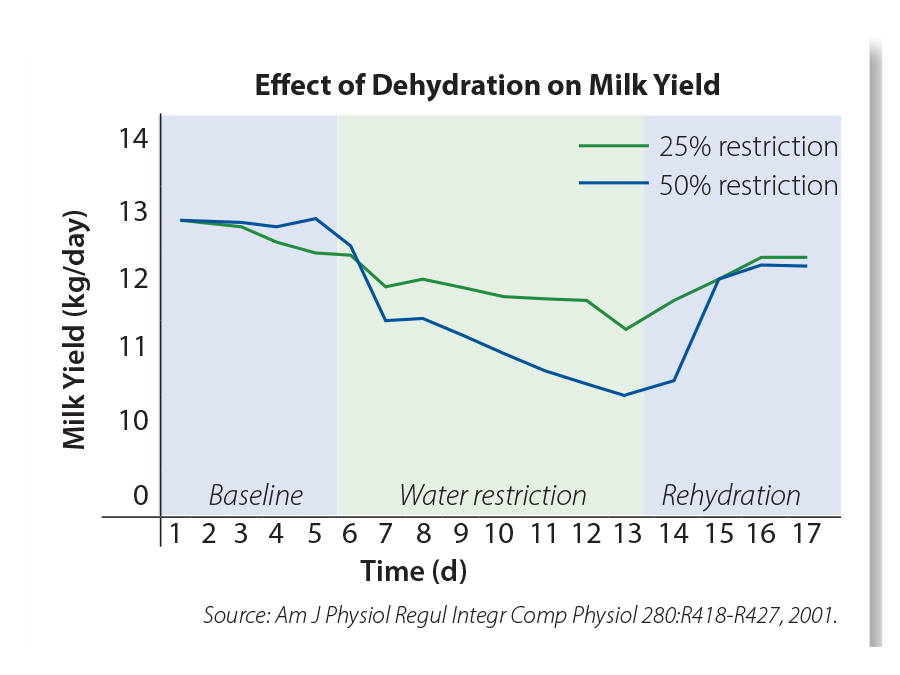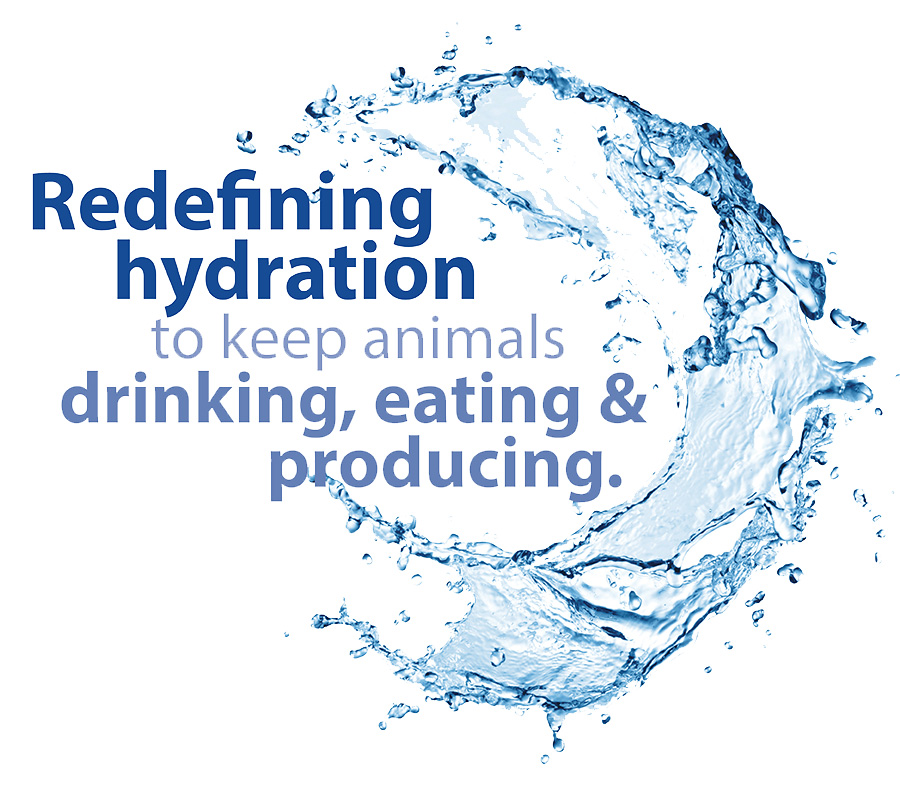Rehydrating the post-freshening cow for a quick recovery.
Dairy producers, nutritionists and veterinarians invest a lot of time and effort on improving management and feeding programs for transition cows. Cows properly managed and fed during the transition period at freshening are shown to have less post-freshening metabolic problems. These cows also get back on feed quicker after freshening and maintain higher dry matter intake which is essential for optimum milk production throughout lactation.

Immediate post-freshening water intake
Researchers and producers have long recognized that dairy cows readily consume large volumes of water immediately post-freshening and shortly after milking. Cows crave water at these times due to the large volumes of fluid and water released or expended through freshening and milking. As an example, cows producing 90 pound calves expend or release about an equal volume of 90 pounds of fetal fluid and membranes at freshening. Post-freshening, cows immediately take action or crave to replenish the fluids lost as seen by their desire to consume 5-10 gallons of water in a short period of time. With research showing that restricted water consumption has a negative impact on milk production, adequate hydration immediately post-freshening is one way to support a quicker recovery, and set up the cow for optimized milk production through lactation.

Field observations indicate that cows will consume 40-50% of their normal daily water intake shortly after milking.
Water loss during milking
Just as cows lose abundant fluids during freshening, milking accounts for significant water utilization. Cows producing 40 pounds of milk at one milking with 8-9 percent solids (40 x 9 + 3.6) will expend about 36.4 pounds or 4.5 gallons of fluid or water in producing these 40 pounds of milk. When cows release these amounts of milk and fluid in 7-10 minutes of milking time for instance, there is a physiologic need to replenish these fluids right away. Field observations indicate that cows will consume 40-50% of their normal daily water intake shortly after milking if sufficient water sources or supplies are readily available. Any deficit in water intake of 4 hours or more, reduces the time the cow’s body has to maximize water utilization for milk production prior to the next milking.
The rumen holding tank
The rumen serves as a reservoir that releases consumed water to the body fluid compartments via osmotic pressure and with the help of microscopic pumps located at the base of gut villi. Electrolytes and other nutrients create osmotic pressure in order to continuously supply the cells with fluid for normal functions. If the body does not have enough fluids, then the amount of nutrients transferred to the cells (for metabolism, etc.) is greatly reduced. Therefore, managing the water content in the rumen is important for maintaining both normal rumen fluid volume as well as other body fluid reserves and metabolism.

Abomasal disorders and the effect of dehydration
Post-freshening, there is more room for the abomasum to “move around” due to space now available without the calf. Encouraging immediate water intake helps to “anchor” the rumen in place and reduces the chance of displacement. Water intake also provides a necessary mechanism for gut function and nutrient dispersion. However, due to continued depression in appetite cows also may not drink right away or in amounts necessary for gut stability or recovery. Additionally, in the presence of even low levels of dehydration, another contributor to abomasal displacement is suppressed appetite (Fig 3) and the resulting imbalance of essential nutrients.
Research¹ shows that 38% of cows with left displacement of abomasum showed clinical symptoms of dehydration, where 57% of cows with right abomasal displacement showed some degree of dehydration. Furthermore, cows with either abomasal volvulus or abomasal impaction were moderately to severely dehydrated in 85% of cases on average.
More research² results suggest that lower potassium levels in blood were associated with low chloride, rise in blood pH (alkalemia), low feed intake with high amount of milk produced, low circulating blood (hypovolemia), and higher blood glucose (hyperglycemia) in lactating dairy cows. Treatment for potassium deficiency should include surgical correction of abomasal displacement, increased dietary potassium intake via dietary dry matter intake or oral administration of KCl (potassium chloride), and correction of the rest of parameters.
How TechMix is Redefining Hydration
Water is the primary transport vehicle for nutrients like vitamins, minerals and energy into the cells but also works to remove waste products and toxins. Hydration starts at the cellular level and is more than just water consumption, rather hydration health is also the provision of critical nutrients through water that support physiologic recovery and health. For the transition cow, this means providing hydration and nutrients in forms convenient for the producer to use and appealing for the cow to consume.
Post-freshening nutrient requirements
Yeast – Depressed feed intake leads to a host of metabolic and performance challenges. Getting the transition cow on feed is critical and yeast helps quickly condition the rumen pH environment – encouraging intake.
Magnesium – A cow’s magnesium level is dependent on diet alone, deficiencies occur when there is a drop in dry matter intake close up or immediately post-freshening. A magnesium deficiency (hypomagnesemia) can also occur when rumen pH rises – placing continued emphasis on improving dry matter intake.
Calcium – Without supplemental dietary calcium the cow’s body pulls calcium from bones to meet physiologic needs. This results in a negative calcium balance (hypocalcemia) that could continue for roughly the first 90 days of lactation. Subclinical hypocalcemia is believed to affect 50% of cows in their second lactation.

Potassium – As the primary electrolyte responsible for intracellular energy mobilization and utilization, potassium is also responsible for the fluid balance within cells and for a proper body function. Without the ability to manage potassium levels in the blood, sources must come from the diet to ensure recovery and support cell activity.
Taking a fresh look at freshening
Post-freshening rehydration and nutient supplementation are key requirements to maximizing nutrient utilization, establishing good hydration health status, and optimizing lactation. Many transition cow challenges can be mitigated with the right hydration and nutrients delivered at right time – through immediate post-freshening rehydration. Equally important is the delivery and access to sustained, enriched hydration support throughout the entire lactation to help ensure subclinical dehydration isn’t allowed to degrade health or compromise performance. At TechMix we are commited to keeping animals drinking, eating and producing.
